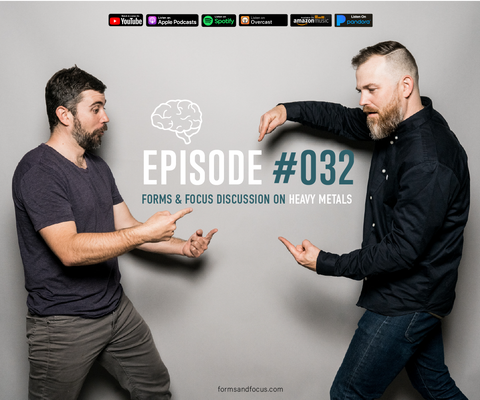
#32 Forms and Focus Discussion Heavy Metals
Heavy Metal may sound good (when your favorite band drops a nasty breakdown), but heavy metals are extremely toxic for our brains. In this episode, we will talk about a few known metals: Lead, Aluminum and Mercury, how they enter our brain, how these metals impact our ability to focus, and what we can do today to limit exposure, reduce metals in our brains and accomplish our dreams. Let’s dig in…
0:00 Intro to Inflammation
0:34 Intro to Podcast
1:05 How Heavy Metals Effects Focus
10:09 Solution to Increasing Creativity
LISTEN TO EPISODE
WATCH EPISODE
SHOW NOTES FOR EPISODE #32
PROBLEM
Lead: Lead is a chemical element with the symbol Pb and atomic number 82 which group 14. Lead is widely used for car batteries, pigments, ammunition, cable sheathing, weights for lifting and more.
Article on NLBI: Lead in the brain: At the molecular level, lead interferes with the regulatory action of calcium on cell functions and disrupts many intracellular biological activities which damages the prefrontal cerebral cortex, hippocampus, and cerebellum
Which can lead to… brain damage, behavioral problems, nerve damage, and possibly Alzheimer’s disease, Parkinson’s disease, and schizophrenia.
A 2018 study published in The Lancet Public Health suggests that of the 2.3 million deaths every year in the US, about 400,000 are attributable to lead exposure, of which 250,000 are from cardiovascular disease.
The EPA estimates that 10 to 20 percent of human exposure to lead may come from lead in drinking water as demonstrated in water testing throughout the United States. https://www.ewg.org/tapwater/reviewed-lead.php)
Aluminum: Aluminum is a chemical element with the symbol Al and atomic number 13. Aluminum is used in transportation, construction, electrical and consumer goods.
Article found on Rezilir Health: It has been researched for decades that once aluminum enters the body, it bio-accumulates in brain tissue and contributes to cognitive impairment and memory loss.
Significant amounts of aluminum can be found in food emulsifiers, antiperspirant deodorants, hair sprays, baking powder, many types of toothpaste, in our drinking water, and in much of our cookware, exposing us to high amounts over the course of one’s lifetime.
NOTE: Recently, the final piece of the puzzle may have fallen into place: the connection between aluminum and fluoride. New research has revealed that fluoride in drinking water makes the aluminum that we ingest more bio-available. As was reported in Brain Research (Vol.7 84:98), the combination of aluminum and fluoride causes the same pathological changes in brain tissue found in Alzheimer’s patients.
Mercury: Mercury is a chemical element with the symbol Hg and atomic number 80. It is also a good conductor of electricity, so it is a useful component of electrical switches. Mercury is also used in dental fillings, paints, soaps, batteries, and fluorescent lighting.
Article in NCBI: Many studies show that high exposure to mercury induces changes in the central nervous system, potentially resulting in irritability, fatigue, behavioral changes, tremors, headaches, hearing and cognitive loss, dysarthria, incoordination, hallucinations, and death.
Article found on Rezilir Health: But the major source of mercury is found in our food chain and is responsible for about 1/3 of the levels found in our bodies. Mercury that naturally occurs in coal production is released during burning and enters the air; it is then precipitated into the oceans, lakes, and rivers by rain.
According to the EPA, coal-fired power plants in the United States emit about 48 tons of mercury into the air every year. This works it’s way up the food chain to us.
Effects on brain functioning may result in irritability, tremors, changes in vision or hearing, and memory problems. The term, “Mad Hatter,” refers to 19th Century workers who used mercury to make hats and went bald and suffered from severe muscular tremors, dementia, and fits of wild, uncontrollable laughter.
SOLUTION
What Can We Do?
- Avoid cosmetics containing aluminum, such as deodorants
- Avoid beverages in aluminum cans
- Ceramic dental fillings instead of amalgam
- Give preference to organic foods: On average, organic food has 68% less cadmium
- Avoid excessive amounts of seafood: DO NOT EAT FARM RAISED FISH
- Use water filters
- Some foods you can eat that are natural heavy metal detoxes: "cilantro, garlic, wild blueberries, lemon water, spirulina, barley grass juice powder, green tea, tomatoes
- Vitamin B, B-6, and C deficiencies are associated withTrusted Source poor tolerance of heavy metals and easier toxicity. Vitamin C has been reported to have chelating effects on iron. In one animal study, B-1 supplements were shown to decrease iron levels.
FIND US
https://formsandfocus.com/
https://www.instagram.com/formsandfocus/
https://www.tiktok.com/@formsandfocus
#focus #podcast #heavymetals

Comments (0)
There are no comments for this article. Be the first one to leave a message!